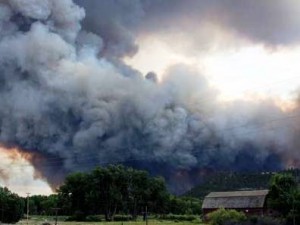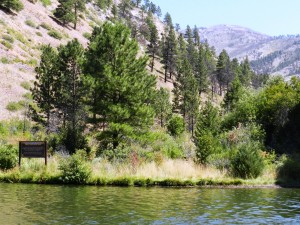» posted on Saturday, August 11th, 2012 by Linda Lou Burton
Red Flag Flying
 Linda Burton posting from Helena, Montana – I finally put two and two together this morning. My eyes had been burning like crazy for several days; no amount of eye drops seemed to help. Was I spending too much time staring at the computer screen? I’d had a nagging little night cough too; it seemed to begin when I opened the window for some fresh air as I went to bed. But come to think of it, I hadn’t been able to see the Sleeping Giant mountain for several days; the valley was covered in haze. Maybe the air wasn’t so fresh, after all. On my way to breakfast, I stopped at the front desk and asked. “Yes, there’s a forest fire burning to the north,” she confirmed. “All that smoke in the valley is bad for a person’s allergies.” Allergies, and eyes, I thought. Back in my room, I closed my window and sat down with my coffee to find what I could about forest fires in Montana. The InciWeb Incident Information System at the Montana State Travel Site quickly brought me up to date. http://visitmt.com/fire/conditions.htm
Linda Burton posting from Helena, Montana – I finally put two and two together this morning. My eyes had been burning like crazy for several days; no amount of eye drops seemed to help. Was I spending too much time staring at the computer screen? I’d had a nagging little night cough too; it seemed to begin when I opened the window for some fresh air as I went to bed. But come to think of it, I hadn’t been able to see the Sleeping Giant mountain for several days; the valley was covered in haze. Maybe the air wasn’t so fresh, after all. On my way to breakfast, I stopped at the front desk and asked. “Yes, there’s a forest fire burning to the north,” she confirmed. “All that smoke in the valley is bad for a person’s allergies.” Allergies, and eyes, I thought. Back in my room, I closed my window and sat down with my coffee to find what I could about forest fires in Montana. The InciWeb Incident Information System at the Montana State Travel Site quickly brought me up to date. http://visitmt.com/fire/conditions.htm
The Elbow Pass Complex Incident was likely the source of the haze I could see; four lightning ignitions in the Lewis and Clark National Forest beginning in July; 25 miles southwest of Augusta (that’s north of Helena); 17,454 acres and 81 personnel involved; growth potential High; terrain difficulty Extreme. Evacuations were ordered for the Benchmark Road Corridor almost two weeks ago. The USDA Forest Service has an Active Fire Mapping site; a map of Current Large Incidents in the US allows you to click on any spot in the country for information; easy to find out about your local area. http://activefiremaps.fs.fed.us/index.php;
 Helena’s Independent Record also posts daily reports on area fires, giving not only details but a sense of the human impact, and the urgency; here’s an excerpt from their June 25, 2012 issue: Authorities ordered evacuations Monday for 200 residents north of Helena and a dozen homes in a rural community southeast of Whitehall, as scorching heat and strong winds fueled wildfires across western Montana. Gawkers blocked traffic in the Helena Valley and watched helicopters dump buckets of water in the Scratchgravel Hills. Lewis and Clark County Sheriff Leo Dutton ordered bystanders to leave for their own safety. The Red Cross opened a shelter for evacuees at a nearby church, trailers carried horses and livestock from the evacuation area, and authorities blocked traffic from entering a major thoroughfare crossing the Helena
Helena’s Independent Record also posts daily reports on area fires, giving not only details but a sense of the human impact, and the urgency; here’s an excerpt from their June 25, 2012 issue: Authorities ordered evacuations Monday for 200 residents north of Helena and a dozen homes in a rural community southeast of Whitehall, as scorching heat and strong winds fueled wildfires across western Montana. Gawkers blocked traffic in the Helena Valley and watched helicopters dump buckets of water in the Scratchgravel Hills. Lewis and Clark County Sheriff Leo Dutton ordered bystanders to leave for their own safety. The Red Cross opened a shelter for evacuees at a nearby church, trailers carried horses and livestock from the evacuation area, and authorities blocked traffic from entering a major thoroughfare crossing the Helena  Valley. Fire officials from the city, East Helena, and the state responded, and Dutton said he also asked for assistance from the military. Red-flag conditions caused new fires to ignite and existing fires to spread. Temperatures in the region topped 90 degrees, while the humidity was expected to drop below 15 percent, and the wind was expected to blow at 25 mph with gusts up to 35 mph. The National Weather Service issued the red-flag warning until 9 pm for southwestern Montana, stretching from the Idaho border to north of Helena. http://helenair.com/
Valley. Fire officials from the city, East Helena, and the state responded, and Dutton said he also asked for assistance from the military. Red-flag conditions caused new fires to ignite and existing fires to spread. Temperatures in the region topped 90 degrees, while the humidity was expected to drop below 15 percent, and the wind was expected to blow at 25 mph with gusts up to 35 mph. The National Weather Service issued the red-flag warning until 9 pm for southwestern Montana, stretching from the Idaho border to north of Helena. http://helenair.com/
 Fire! Tornados and tsunamis are terrifyingly destructive, hurricanes and floods are devastating in scope, earthquakes and volcanic explosions change the landscape forever. But a windswept forest fire may be the most frightening natural disaster of all; there’s the heat; there’s the swiftness; there’s the loss of oxygen in the very air we breathe. Alongside the Missouri River in the Helena National Forest stands a National Register of Historic Places sign remembering the deadly Mann Gulch fire. It reads: On August 5, 1949 a lightning-caused wildfire entrapped a smokejumper crew in this steep canyon. Before it was controlled it took the lives of 13 men and burned nearly 5,000 acres. The lessons learned from this tragic event continue to influence wildland fire fighting.
Fire! Tornados and tsunamis are terrifyingly destructive, hurricanes and floods are devastating in scope, earthquakes and volcanic explosions change the landscape forever. But a windswept forest fire may be the most frightening natural disaster of all; there’s the heat; there’s the swiftness; there’s the loss of oxygen in the very air we breathe. Alongside the Missouri River in the Helena National Forest stands a National Register of Historic Places sign remembering the deadly Mann Gulch fire. It reads: On August 5, 1949 a lightning-caused wildfire entrapped a smokejumper crew in this steep canyon. Before it was controlled it took the lives of 13 men and burned nearly 5,000 acres. The lessons learned from this tragic event continue to influence wildland fire fighting.
The fire was first reported around noon and the Forest Service dispatched smokejumpers from Missoula to the remote area; two of them were new and inexperienced. Based on the information they had on departure, they had a plan, landing about a half mile from the fire. But things quickly changed; high winds caused a blowup; the fire expanded to 3,000 acres in 10 minutes, cutting off their route and forcing them uphill on the steep canyon slopes.
With the fire less than 100 yards away, crew foreman Wagner Dodge set a small “escape” fire, creating a burned-over area that the fire would bypass. He directed the group to the area, but in the confusion they continued going up the steep incline away from the fire. The two newest, Walter Rumsey and Robert Sallee, found shelter inside a small crevice in the canyon’s rock wall. These three were the only survivors; the rest of the crew, it was determined later, suffocated and fell as the fire approached. Dodge lay face down as the fire swept over him; although its force lifted him several times, it quickly passed over the already-burnt area, allowing him to breathe.
It took 450 men five more days to get the fire under control. Today twelve crosses and a Star of David mark the locations where the thirteen fell. The events at Mann Gulch had a great influence on wildfire suppression and fire research. New training techniques and safety measures were put in place by the Forest Service, in hopes that such a tragedy would never be repeated. The USFS has a history page where you may read about the Mann Gulch Fire and other fires. http://www.foresthistory.org/ASPNET/Policy/Fire/FamousFires/MannGulch.aspx
 Many books have been written about the lives lost and lessons learned on that fateful day, including Norman Maclean’s Young Men and Fire (University Of Chicago Press; 1992; ISBN-10: 0226500616); it took him 14 years to write and won a National Book Critics Circle Award. Maclean is a native of Missoula, Montana. I’m ordering a copy for my Kindle today.
Many books have been written about the lives lost and lessons learned on that fateful day, including Norman Maclean’s Young Men and Fire (University Of Chicago Press; 1992; ISBN-10: 0226500616); it took him 14 years to write and won a National Book Critics Circle Award. Maclean is a native of Missoula, Montana. I’m ordering a copy for my Kindle today.

